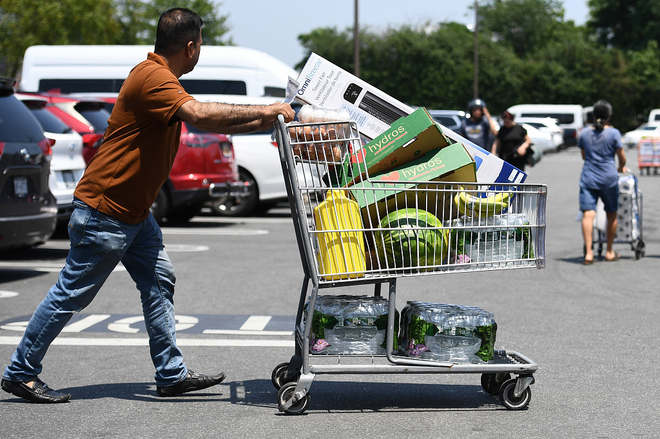Xu Xiaoqing: Data Shows U.S. Economy Returning to Lower Growth Rates (AI Translation)
Listen to the full version


文|徐小庆
By Xu Xiaoqing
2024年5月美国服务业PMI重新回升至55附近,非农就业人数大幅增至27万人,为今年单月第二高,这些数据似乎显示美国经济保持很强韧性。但如果观测更多经济指标,尤其是消费、收入和家庭就业等最能体现美国经济景气度成色的关键指标,会发现其增速已明显放缓至疫情前水平,说明美国经济正在从过去几年的高增长向低增长回归。
In May 2024, the U.S. services PMI rebounded to around 55, and non-farm payrolls surged to 270,000, marking the second-highest monthly increase this year. These figures seem to indicate that the U.S. economy is demonstrating substantial resilience. However, a closer look at more economic indicators, particularly those reflecting consumption, income, and household employment, reveals that their growth rates have significantly slowed to pre-pandemic levels. This suggests that the U.S. economy is transitioning from the high growth rates of recent years back to lower growth.
首先,从今年开始,美国居民实际可支配收入月环比增速已低于疫情前。美国劳动力市场供不应求的状况明显缓解,职位空缺数与失业人口数的比值回落至接近疫情前的水平,美国居民的薪酬月环比增速保持在0.5%左右,仅略高于疫情前的0.4%。更重要的是,扣除税负后的可支配收入环比增速已和疫情前差不多。
First, starting from this year, the month-on-month growth rate of actual disposable income for U.S. residents has fallen below pre-pandemic levels. The supply-demand imbalance in the U.S. labor market has significantly eased, with the ratio of job vacancies to unemployed individuals returning to nearly pre-pandemic levels. The month-on-month growth rate of U.S. residents' wages has remained around 0.5%, only slightly higher than the pre-pandemic rate of 0.4%. More importantly, the month-on-month growth rate of disposable income, after accounting for taxes, is now almost the same as it was before the pandemic.
收入放缓、储蓄减少导致居民消费能力显著下降。虽然居民消费额月环比仍高于疫情前均值,但商品消费已现负增长,只有服务消费环比显著高于疫情前。剔除物价因素后,实际零售消费量整体环比增速已低于疫情前,即使韧性最强的服务消费量也仅略高于疫情前。
A slowdown in income growth and a decrease in savings have significantly reduced residents' consumption capacity. Although monthly household spending remains higher than the pre-pandemic average, consumption of goods has shown negative growth, with only service consumption significantly surpassing pre-pandemic levels on a month-over-month basis. When adjusted for inflation, the overall month-over-month growth rate of real retail consumption has fallen below pre-pandemic levels, with even the most resilient service consumption only slightly higher than before the pandemic.

- DIGEST HUB
- The U.S. services PMI rebounded to around 55 in May 2024, and non-farm payrolls surged to 270,000, indicating substantial economic resilience.
- However, growth in consumption, income, and household employment has significantly slowed to pre-pandemic levels, suggesting a transition back to lower growth rates.
- High-interest rates have led to deteriorating consumer credit and rising default rates, while inconsistencies between unemployment and non-farm employment data suggest a decline in job quality.
In May 2024, the U.S. services PMI rebounded to around 55, and non-farm payrolls surged to 270,000, marking the second-highest monthly increase this year [para. 1]. This shows substantial economic resilience, but other indicators reveal that growth in consumption, income, and household employment is slowing to pre-pandemic levels [para. 1].
Beginning this year, the month-on-month growth rate of actual disposable income for U.S. residents has fallen below pre-pandemic levels [para. 2]. The imbalance in the U.S. labor market has significantly eased, with job vacancies to unemployed individuals returning to nearly pre-pandemic levels. Monthly wage growth has remained around 0.5%, only slightly higher than the pre-pandemic rate of 0.4%. The month-on-month growth of disposable income, after accounting for taxes, is now almost the same as before the pandemic [para. 2].
This slowdown in income growth and a decrease in savings has reduced residents' consumption capacity [para. 3]. Although household spending remains higher than pre-pandemic levels, consumption of goods has shown negative growth, with only service consumption significantly surpassing pre-pandemic levels month-over-month [para. 3]. Adjusted for inflation, the overall month-over-month growth rate of real retail consumption has fallen below pre-pandemic levels, and even service consumption growth is only slightly higher than before the pandemic [para. 3].
The wealth effect of the stock market on consumption has weakened [para. 4]. Despite the US stock market surging nearly 30% over the past year, the effect on consumption growth has been minimal. This reflects the widening income gap among American residents post-pandemic. Low- to middle-income groups, who only hold 4.5% of their assets in stocks, are less affected by stock market performance [para. 4]. Additionally, recent gains in the market are concentrated in a few stocks, meaning most residents don’t benefit from the stock market's wealth effect [para. 4].
High-interest rates have led to deteriorating consumer credit, with default rates surpassing levels seen at the beginning of the last rate cut cycle [para. 5]. By the end of the first quarter of 2024, the delinquency rate on bank credit card loans rose to 3.2%, compared to a peak of 2.7% during the Fed’s rate cuts from 2019 to 2020. Auto loan default rates have also continued to rise, second only to peak levels during the subprime mortgage crisis [para. 5].
Despite the rising non-farm employment, the continuously rising unemployment rate indicates a decline in job quality [para. 6]. Non-farm employment has averaged above 250,000 monthly since 2023, far exceeding pre-pandemic levels, but the unemployment rate has risen to 4%, surpassing its rolling 27-month average [para. 6]. Historically, this trend often signals the onset of an economic recession [para. 6]. Data discrepancies between household survey employment figures and employer survey data further complicate the picture [para. 6].
The slowdown indicates that the marginal effect of fiscal easing is diminishing [para. 7]. Post-pandemic, U.S. fiscal expenditures as a percentage of GDP have significantly increased, while fiscal revenues remained unchanged. This implies that interest payments on national debt rely more on fiscal deficits from the new fiscal year. High-interest rates could raise interest payments to 20%-30% of fiscal expenditures in the next one to two years, which challenges the effectiveness of fiscal policy in stimulating the economy [para. 7].
The article questions whether U.S. stocks can continue to rise in an economic slowdown, especially if the Federal Reserve initiates a rate-cutting cycle in the latter half of the year [para. 8]. Since the beginning of the year, U.S. stock surges have primarily been driven by heavyweight technology stocks, while broader indexes like the Dow Jones Industrial Average have seen limited gains [para. 8]. Historically, a divergence between different stock indexes often signals a turning point [para. 8]. Currently, the ratio of the Dow to NASDAQ has fallen to around 2%, a historically low level seen only twice before, both times indicating a forthcoming market adjustment [para. 8].
- Dunhe Asset Management Co., Ltd.
敦和资产管理有限公司 - Dunhe Asset Management Co., Ltd. is an investment management firm. The author of the article discussing the state of the U.S. economy, particularly its resilience and the implications for various economic indicators, is the Macro Strategy Director at this company. The firm focuses on providing macroeconomic analysis and strategic investment advice.
- Since the beginning of 2023:
- The monthly average of non-farm employment has been consistently above 250,000.
- Third quarter of 2023:
- Unemployment rate rebounded from its low point.
- By the end of the first quarter of 2024:
- The delinquency rate on bank credit card loans rose to 3.2%.
- May 2024:
- U.S. services PMI rebounded to around 55, and non-farm payrolls surged to 270,000.
- As of mid-May 2024:
- The Dow Jones Industrial Average has been on a continuous decline.
- GALLERY
- PODCAST
- MOST POPULAR





 Sign in with Google
Sign in with Google
 Sign in with Facebook
Sign in with Facebook
 Sign in with 财新
Sign in with 财新